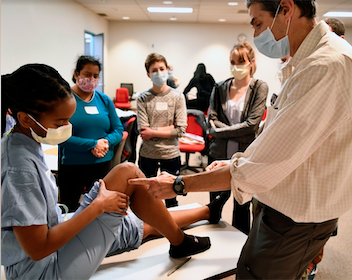Sports Medicine II: Procedures in Sports Medicine

Dates:
- Thursday, February 22, 2024 (8:00 a.m.- 4:45 p.m.)
Location: Health Sciences Education Center
Sports Medicine II gives participants hands-on instruction with sports injuries, procedures, and management. Participants learn in small-groups, guided by faculty.
Note: Sports Medicine I is not a prerequisite for this course.
- Bracing
- Casting
- Injections
- Musculoskeletal ultrasound
- Splinting
Registration is for non-University of Minnesota family medicine residents, medical students, and community physicians or healthcare professionals. Fees include tuition, syllabus, parking, and lunch.
- Contact:
Heidi Cerdas Monge, MBA, hcerdasm@umn.edu
Bracing
- Appreciate the role of bracing in the management of soft tissue and osseous injury for the wrist, knee, foot, and ankle
- Examine the variance in material construction, design characteristics, and resulting functional motion with various brace designs
- Understand appropriate fitting, modification, and patient instruction required for various brace designs
Casting
- Appreciate a historical review of immobilization
- Understand common complications after casting
- Practice performing extremity immobilization, including the following:
- short arm cast
- short arm thumb spica cast
- short arm with gutter extension
- non‐weight bearing short leg cast
Injections
- Increase the number of soft tissue and joint injections that can be performed comfortably and competently before completing residency
- Be aware of serious complications that can occur with specific soft tissue and joint injections
- Learn three different approaches to intra‐articular knee injections
- Identify substances commonly used for therapeutic injections for joint and musculotendinous problems
- Understand the quality of evidence regarding injection therapies
- Appreciate the relative accuracy of therapeutic injections
- Practice performing injection on simulated model
Musculoskeletal Ultrasound
- Appreciate the emerging role of musculoskeletal ultrasound in the diagnosis and management of musculoskeletal injuries
- Recognize specific knee and hip ultrasound anatomy
- Understand the advantages and disadvantages of MSKUS as an imaging modality
- Appreciate the use of ultrasound in the examination of the shoulder, wrist, and elbow
- Identify useful procedures that can be enhanced using MSKUS
- Grasp the factors that may limit the application of MSKUS in upper extremity imaging in the office setting
- Practice performing ultrasounds
Photo & Video Release
We may take photos and/or videos of instructors and learners at our programmatic courses, and these may appear in the department’s and/or University of Minnesota’s marketing and promotional materials (e.g., brochures, posters, social media, websites, etc.). Your attendance constitutes your permission and consent for photography and video subsequent usage. If you do not want to be photographed or filmed, please let us know by contacting Heidi Cerdas Monge, MBA, 612-625-0953, hcerdasm@umn.edu.
"Great topics! Very comprehensive coverage!"
